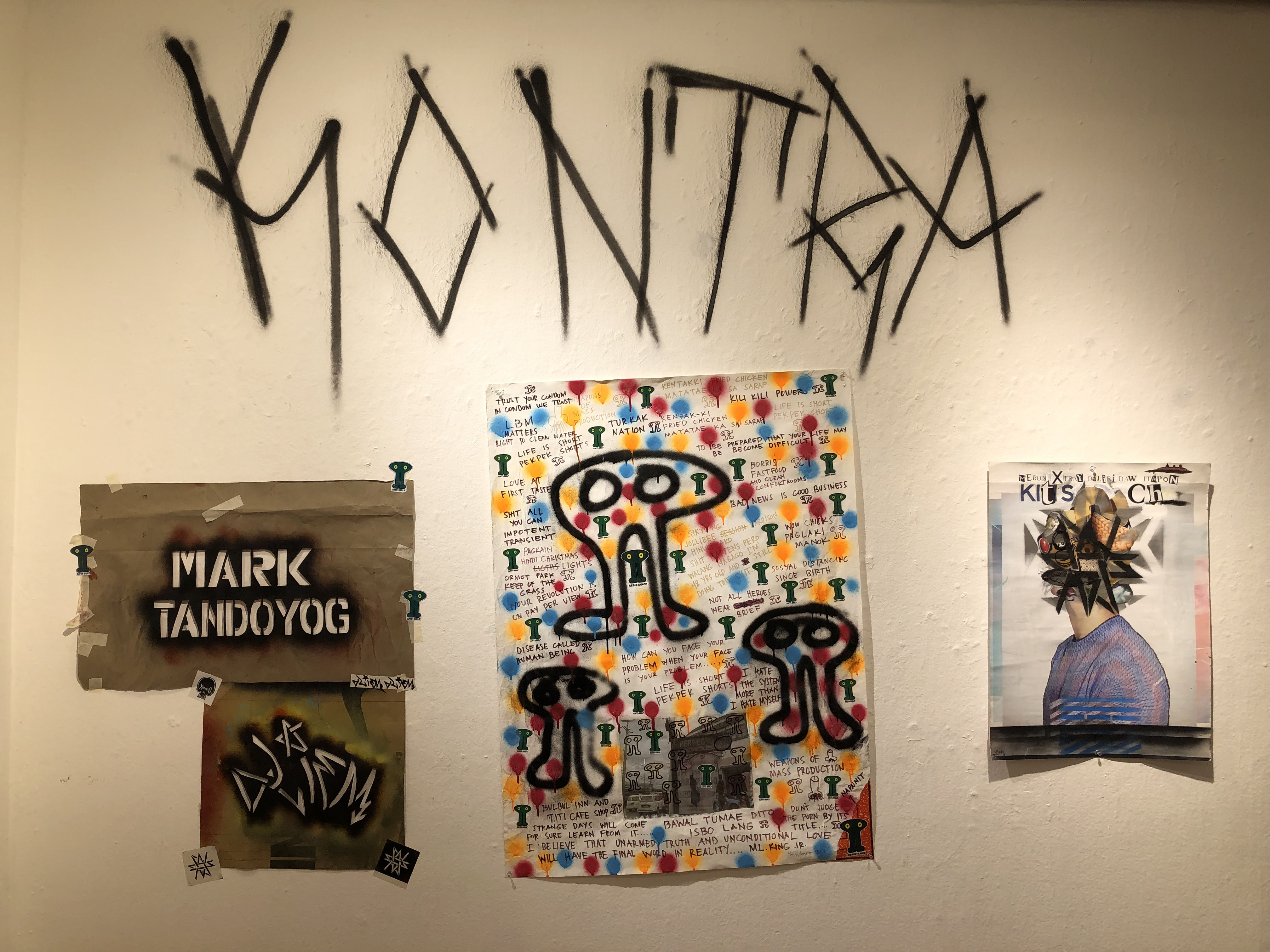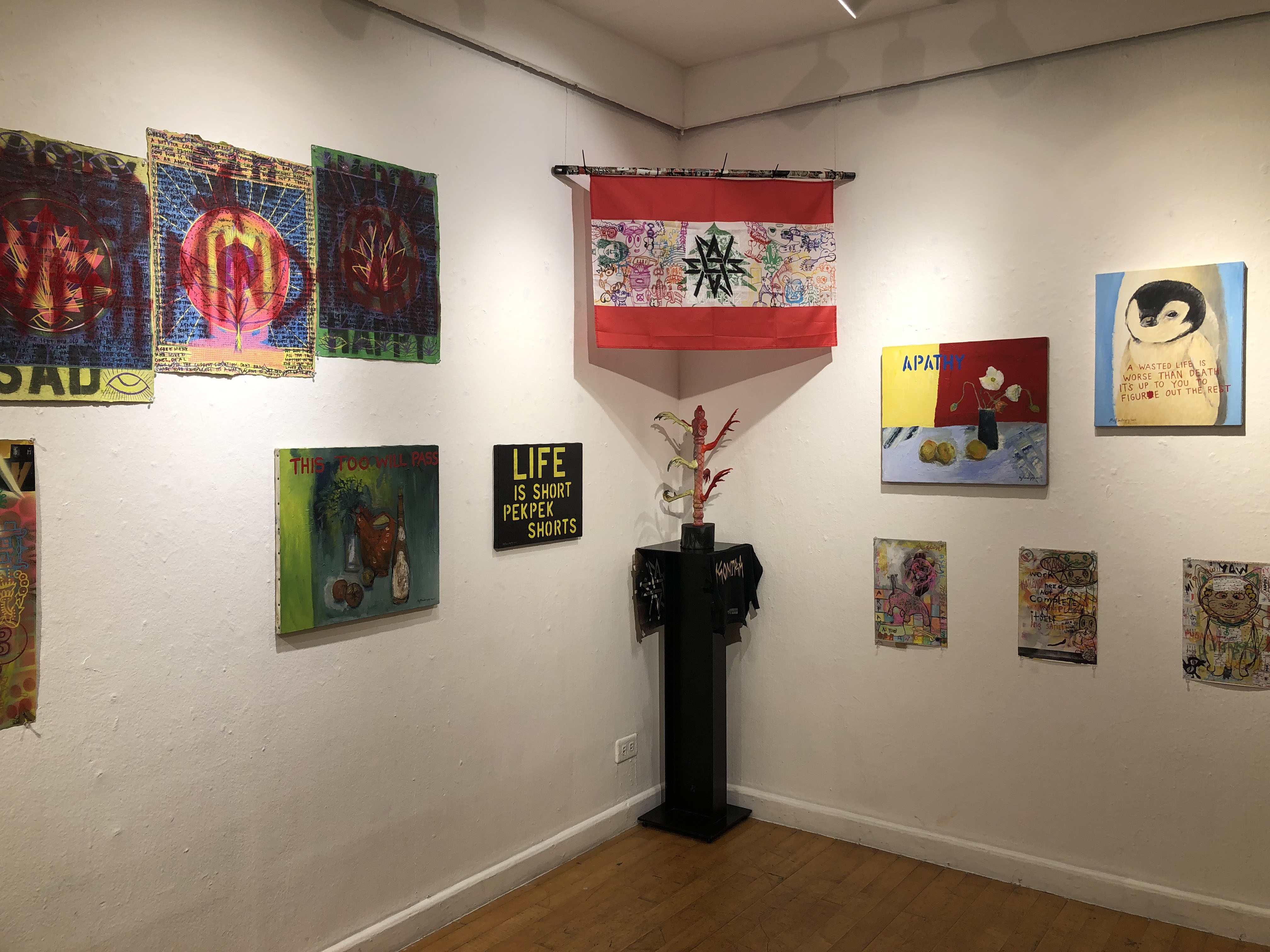Poser! Sellout! are call-outs that can re-orient self-proclaimed anarchists. These can also weed out those just doing it for the ‘gram, for the “aesthetic.” If anyone has the right to say “Punk is Not Dead,” it’s those who have devoted their lives to the movement.
It’s romantic to die for a cause but actually, truly heroic to keep living for it.
Enter Kontra, a two-man show by Neil Arvin Javier (alias A.lien) and Mark Tandoyog, launched last September 5 at the Crucible Gallery in SM Megamall. A flash of lightning to jolt lucky ones awake, the show, featuring a mix of new and old work by each artist, ran until September 17.
Poser! Sellout! One may understandably accuse Javier and Tandoyog for mounting a show in a space presently associated with consumer capitalism, but I’d say it’s even more radical if you look closely at the bigger context.
Punk started as a counter-cultural movement critical of mass consumerism and related trends in the Western world following World War 2. It finds resonance with the Beat and Hippie movements that preceded it. It’s all about individualism, a do-it-yourself ethos, and communal anarchy.
The Philippine scene indigenized punk as a protest against neo-colonialist relations and the resulting destruction of the natural world and indigenous systems of knowledge.
As it is with radical social movements, it wasn’t long before mainstream culture and business embraced (or co-opted, depending on who you ask) it. Punk in popular consciousness then became a decoration, a marketing tool, and a genre.
Still, there are those who adhere to its original spirit, and Tandoyog and Javier join their ranks. Both have strongly identified themselves with street culture, “lowbrow” spaces, and colloquial art and communities, if not through word, then definitely through deed.
“I get the vibe of galleries before working with them,” Tandoyog, a Baguio resident, reveals.
“Walking down the rest of the floor,” Javier muses. “I can’t help but notice how different our show is.”
And yet, the same mall with galleries running more “commercial” shows at this point in time also supported all its art spaces by not charging any rent for the first three months of the 2020 pandemic, followed by only charging 30% of the usual amount to keep operations running, reveals Chari Elinzano who has managed the gallery since opening in 1993.
“The Crucible, while showcasing masters like Luz and Orlina here and there, is also about showing other voices, showing as much as voices as possible, showing all voices, if possible,” explains Elinzano,.
“When we say Kontra (Filipino for “opposed to”) we often think of its negative, combative connotation,” Javier shares, “But I was thinking, if you flip it, it spells ‘Art n(a) Ok’, and I was like, yeah, let’s do it!”
“Activism can’t always be angry,” the wizened punk adds. “It’s about yin and yang, work and rest, anger and humor.” Javier finished Fine Arts at the Technological University of the Philippines around the time the Crucible opened its doors. A full-time artist, he frequents skate parks and haunts other meccas of street culture, all while also having participated in mainstream art contests.
He works with found objects and turns them into collages, notably repurposing catalogs from galleries. A true example of DIY and rugged individualism, he also produces mix tapes often featuring noise art interspersed with poetry, publishes comic books, and performs a blend of performance art, spoken poetry, and noise art.
Meanwhile, Tandoyog largely works with words spray-painted onto canvas, one-line works full of snark providing commentary on life in the Philippines.
While irreverent and exuberant, Tandoyog’s works, taken as a whole, tackle hard questions about gentrification, loss-of-place, existentialism, and the joy of thriving amidst the contradictions of life today. A frequent mountaineer, he likes to trail run and hike when not making art.
Tandayog is thankful that spaces like Crucible “let you say what you want to say. What’s the use of working with a gallery that constrains you?” He reveals that there are some galleries he’s refused to work with on the basis of principle.
The exhibit text isn’t also the usual, highfalutin, academic approach, but a poem written by Javier. “Life is a mantra,” it concludes, originally in Filipino.
Javier hesitates to define punk, noting how the term has largely been co-opted as a marketing tool today. Tandoyog notes how he doesn’t want to identify with any movement nor criticize any trend, stating that he simply does what he wants to do in the present time.
These men don’t talk punk. They live it.
“No work is lost,” Elinzano believes. “Even if it takes a while, there will always be someone for whom the artwork is for.” And amidst the show’s brief run, one can tell it was more for the expression than making bank. There are none of the usual details labels below each work, but a catalog could be requested.
And while Elinzano is cautious about associating the gallery with any movement, making a space for alternate worldviews and voices to freely express themselves is in itself quite the statement.
The Crucible is located on the 4th Floor, Building A of SM Mega Mall. Follow the artists on their official Instagram accounts: @a.neil42 and @marktandoyog.
When Pao isn't writing about art, he's trying to be a cat-whisperer.
Images courtesy of the author.



